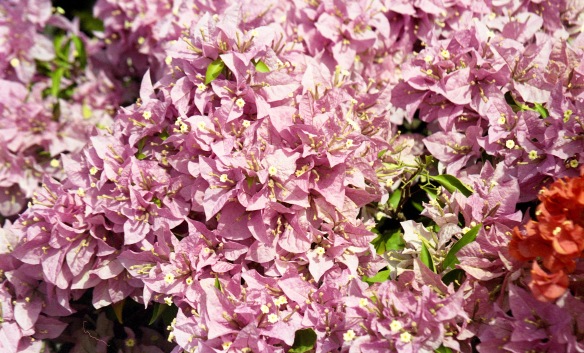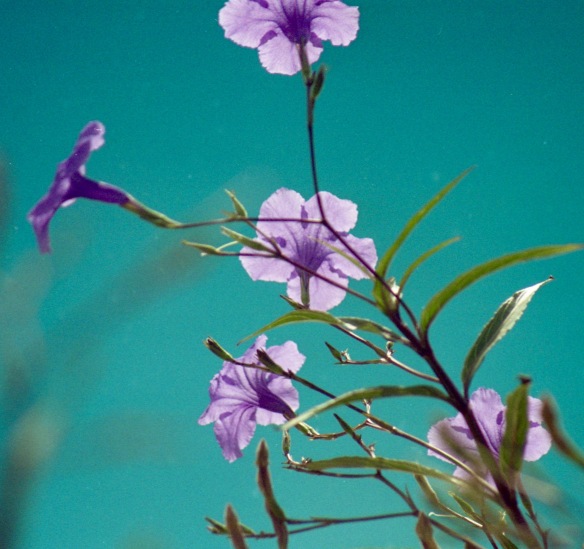(THE TITLE IS THE RESULT OF AN ERROR ON MY PART. AS SEVERAL COMMENTERS HAVE POINTED OUT, MY ASPIDISTRA IS A PLUMBAGO. AH, WELL, IT GAVE AN OPPORTUNITY TO INTRODUCE GRACIE FIELDS. I WON’T CORRECT MY TEXT, BECAUSE THE JOKE IS NOW ON ME, BUT THANKS ARE DUE TO ALL MY EDITORS 🙂
Even though today was Easter Sunday, and the weather was blustery and showery with occasional sunshine, Aaron and Robin finished weeding the gravel paths in the garden.
This afternoon I scanned the penultimate batch of Barbados negatives from March 2004.
These were the last few from the Bridgetown walk and the first from around the Sugar Cane Club hotel to which we transferred when realised that our initial choice, at the southernmost tip of the island, was so far from Port St Charles where Sam would be ending his epic row.
I would be grateful if anyone could identify this rather magnificent tree with its root tentacles.
Here are some more roadside dwellings, both fixed and chattel examples, all with beautifully rusting corrugated iron roofs;
and, naturally, bougainvillea,
hibiscus,
and frangipani.
I couldn’t identify these flowers.
[youtube https://www.youtube.com/watch?v=6XROMw3Z4e0&w=420&h=315]
I also learned that Gracie Fields’s claim for her brother Joe was probably rather dubious.
Their aspidistra couldn’t have been as big as this one.
Our new hotel, near the shores of the Atlantic, was well equipped with sun loungers.
The Ocean itself bore out Homer’s description of the ‘wine-dark sea’.
This evening we dined on roast duck; roast potatoes; colourful and crunchy carrots, broccoli and Brussels sprouts; and gravy so full of goodies as to accommodate a standing spoon. Jackie drank Hoegaarden and I finished one bottle of the madiran and poured a glass from the next, with which I will continue now.














The trunk of the tree looks very like a FIcus Benjamina (Weeping Fig).
Thanks, Sylvia
Gosh, it appears you may be correct and I have one of those in a pot – I’d better be careful it doesn’t take over the tiny garden!! I had to check it out on Wiki as I had no idea!
I also had one in a pot, but fortunately it died before it took over the house. 😀
😀
Strangler fig (Ficus aurea), Mexican petunia (Ruellia brittoniana), and the “aspidistra” is actually a pale Plumbago
Thanks, John. It’s a good thing I put a ? in the title 🙂
I’m glad you made the mistake and drew attention to it, as I’d have probably missed the reference to the picture. We have one or two of these plants ourselves, without my realizing what it was. With its name such a near-miss for
Lumbago, I shan’t forget what it is when it flowers in summer.
Nor me, Paul. Not ever again 🙂
The tree looks like a Banyan, Derrick. The photos are so beautiful. Just what I needed to see to brighten this rainy Easter Sunday.
I had thought a Banyan, Jill – but others have identified a ficus
Wow great tree and very beautiful flower pictures. Happy Easter! bilere
Thanks, bilere
fun post, especially that cheesy imbedded tune!
The tree is a “strangler fig” (Ficus aurea), the blue flower is “Mexican petunia” (Ruellia brittoniana), and the “aspidistra” is actually a pale-flowered Plumbago…
Thanks, felder. The joke is on me
My favorite photograph of the gorgeous hibiscus. Wish I knew the name of the ancient tree, Derrick. Delicious sounding duck, Derrick. 🙂 My regards to the fine chef, Jackie.
Thanks, Robin
I asked my sweetheart about the tree – he suggested Ficus aurea (the strangler fig). It’s certainly a wonderful specimen.
Thanks, Susan – and your sweetheart
It’s definitely some sort of Ficus, I agree. I would say that the blue flowering bush is the plumbago. Aspidistra is a large leaf foliage plant often seen indoors. I want roast duck.
Oh dear, Mary. You are quite right. The joke is on me
love the image of the loungers.
Thanks, Laurie
The trees is “strangler fig” (Ficus aureus), the blue flower is “Mexican petunia” (Ruellia brittoniana), and the “aspidistra” is a pale flowered Plumbago”.
LOVE the imbedded tune….
Many thanks felder. At least my error produce the tune 🙂
So nice to bring back Gracie Fields, and wine dark seas on an Easter sunday.
Thank you, Cynthia
I love ‘the wine dark seas’ reminds me of The Odyssey ………… perhaps I should read it again……..
Thanks, Pauline
I knew it was a plumbago as an aspidistra doesn’t have flowers and has big glossy leaves as others have said – I’ve grown both in years gone by. But despite growing a ficus Benjamina in a pot now I had no idea it could get so big – even if it isn’t actually one of them and turns out to be another type of ficus or a Banyan as Jill suggested which was my initial guess……. What an informative post this turned out to be, I’ve spent ages rummaging around on Mr Google looking at images 🙂
I should have done a bit more rummaging, Pauline. But then the result wouldn’t have been such fun 🙂
That’s right – interactive blogging! 🙂
I’m amazed at the purple* (along with the bands of other colours) in the you’ve captioned abut the wine-dark sea. You’ll wait a long time on a windy beach at Barton for a similar image near to home, I expect.
* I wondered if you’d digitally doctored it, but clearly not.
In fact, it’s the middle one of the three in that set I was especially referring to
Thanks, Paul. It’s the only time I’ve ever seen such colours in the sea
We’ll have a couple of aspidistras for sale in aid of the libraries at your exhibition, Derrick, so we can really rub your nose in it!! (Photos optional)
So kaind, Paul 🙂
Is the tree a Cyprus?
Thanks, Leslie. I think the Ficus aurea (strangler fig) is the answer
I know nothing about trees. It was a wild guess.
Me too
Derrick! Honestly I thought you were the ultimate source of botanical knowledge! 😍 I do love your blog. It’s so filled with peace and beauty. We need both in abundance.
Many thanks, Leslie. All I needed to have done, was ask The Head Gardener, but, for some reason I had labelled the plant ‘aspidistra’ in my photograph album, so didn’t think I needed to. I’m very pleased that you love my blog, especially as yours is such fun
I always feel like I’m at home in your world. It’s a comforting place.
I can’t identify this tree but, indeed, it’s magnificent and its root tentacles are amazing, Derrick 🙂
I also love your ocean’s photos.
Many thanks, Monica
That thing everyone is identifying as some sort of fig is in fact, surely, the White Cliffs of Dover. Just wait for the Bluebirds!
A pretty good Sally, Bruce
Definitely a banyan tree. They grow all over the place here in Bangalore.
Thanks, both of you. I had originally thought banyan
The tree’s identity is secondary – not as important here as the wonderful, evocative photographs you took on your holiday…
But, truth is, banyan tree and a strangler fig are common names for two very similar species of tropical fig trees. One is native to India, the other is native to the Caribbean. It’s like calling a Narcissus a daffodil – one is the Latin name for the other. But there are different TYPES of Narcissus, which is where being precise is of interest only to horticulturists.
I am a horticulturist who has spent decades studying cemetery plants in the Tropics of three continents and Caribbean Islands… My studied opinion is that this is the Fiorida strangler fig, which is native to the Carribean, not the Itrue banyan which is native to India.
If someone wants to call it a banyan. no problem – except to us horticulturists.
But the MAIN point is, your photographs and your blog are fun!
Many thanks, John, for the elucidation, and for appreciating the fun
You’re going to need that extra madiran after that screwup! Haha, just kidding, Derrick. I find it so difficult to identify vegetation. I do know that we have bougainvillea and hibiscus and frangipani in our yard! But it becomes so difficult beyond that. All our Arizona trees look so much alike, so instance: various types of palo verde, mesquite, sweet acacia.
Thanks, Luanne. The thing is I knew it was plumbago, but I hadn’t when I took the photo and for some reason labelled it incorrectly. Never mind – it entertained 🙂
Hah, yes, it has been entertaining! And we all know you know your stuff!
Wow that tree is so amazing derrick!
Thanks, Lynn
🙂
By the way, you never know how far a blog post will travel… For many years now I have hosted a weekly garden program on NPR (America’s BBC), during which I always play a garden tune…and I just downloaded your Gracie Field tune, and am running it on this week’s broadcast – with credit to your blog for learning about it, of course!
(Though I am an American horticulturist and author, I live in and broadcast my program live from a small village in Lancashire several months of every year – only a few miles from Rochdale where Dame Field was born.)
Cheers!
Many thanks, John. Fascinating
Everyone else beat me to it! All I can say is one day, I too want to visit the tropics! 🙂
Thanks, Anna
Very cool!
Thanks, Claire Marie. It turned out to be fun 🙂
That was fun. Loved the first two pictures and the ostentatious hibiscus. And Claire, whoever she was, had quite a song to offer.
Gracie Fields was a very popular Lancashire lass who began a career in the 1930s that must have lasted almost 50 years. Thanks, Cynthia
Whenever I see the word of your title I am reminded of the time I was feeling very down, and read the complete works of George Orwell, including “Keep the Aspidistra Flying”. Here’s a tip for free. Reading Orwell is no cure for depression! 😀 Great photos as usual, even of something so humble as plumbago, almost considered a weed by some Aussie Gardeners as it flourishes so easily in our climate. We had a blue one in a previous house. And oleander too.
Thanks very much, Gwen. Useful tip 🙂